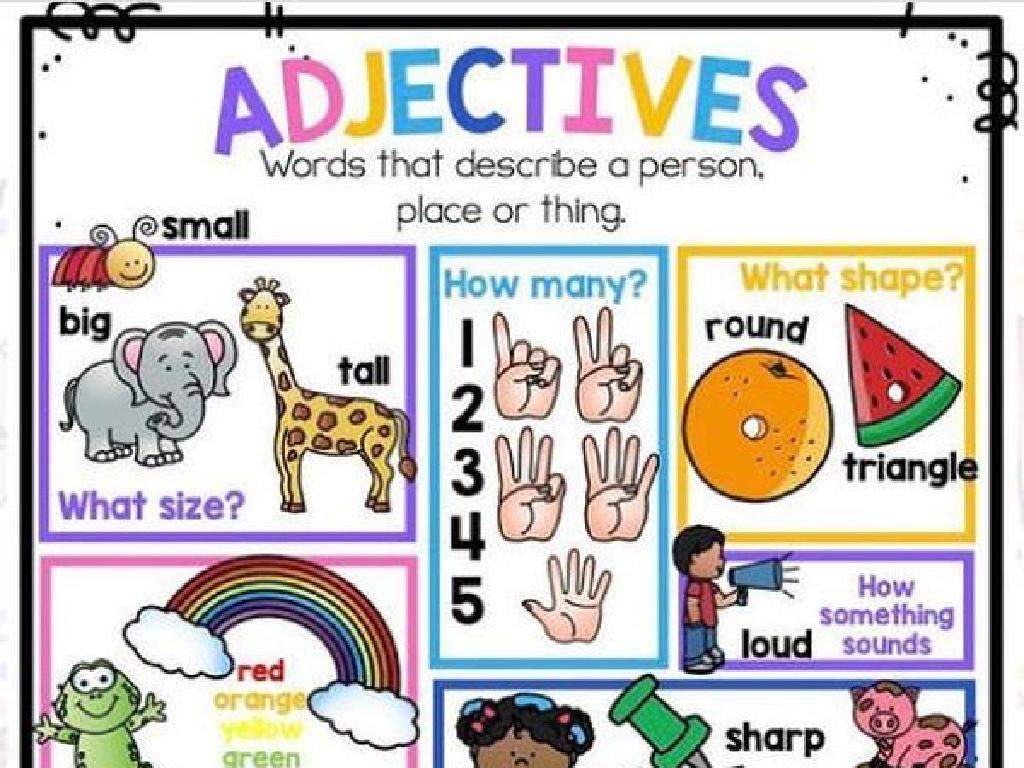Use Data To Describe Climates
Subject: Science
Grade: Eighth grade
Topic: Weather And Climate
Please LOG IN to download the presentation. Access is available to registered users only.
View More Content
Introduction to Weather and Climate
– Weather vs. Climate
– Weather is short-term, climate is long-term patterns.
– Measuring Weather
– Temperature, humidity, precipitation, and wind are measured.
– Defining Climate
– Climate describes the average weather conditions over a long period.
– Weather and Climate Differences
|
Begin the lesson by explaining that weather refers to the day-to-day state of the atmosphere in a region, including temperature, humidity, precipitation, and wind, which are all measurable elements. Emphasize that weather is what we experience in the short term. In contrast, climate is the average of these weather elements over a long period, typically 30 years or more, which helps us identify patterns and make predictions. Highlight the importance of distinguishing between weather and climate, especially in discussions about climate change. Provide examples of weather measurements and discuss how these data contribute to our understanding of climate. Encourage students to think about the climate in their own region and how it differs from the weather they observe daily.
Factors Affecting Climate
– Major climate influencers
– Latitude’s impact on climate
– Closer to equator = warmer climate, farther = cooler
– Elevation and cooler temperatures
– Higher altitudes have thinner air, which cools faster
– Ocean currents’ climate role
– Warm and cold currents affect temperature and precipitation along coasts
|
This slide aims to introduce students to the various factors that influence climate. Start by discussing the major influencers of climate, setting the stage for a deeper dive into each factor. Explain how latitude affects climate by discussing the concept of solar radiation and the angle at which it hits different parts of the Earth. For elevation, describe how the atmosphere becomes less dense at higher altitudes, leading to lower temperatures. Lastly, discuss the role of ocean currents in transferring heat across the planet, influencing coastal climates by bringing warm or cold water to different regions. Use maps and diagrams to visually represent these concepts, and encourage students to think of real-world examples, such as why it’s colder on a mountain than at its base.
Exploring Climate Zones
– Identify global climate zones
– Climate zones are regions with distinct weather patterns.
– Characteristics of key zones
– Tropical: warm, rainy; Temperate: moderate; Polar: cold, icy.
– Climate impact on living conditions
– Warmer zones support more diverse life; extreme zones challenge survival.
– Climate zones and biodiversity
– Richness of species varies with climate; tropics have the highest biodiversity.
|
This slide aims to introduce students to the concept of climate zones and their global distribution. Emphasize the three main climate zones: tropical, temperate, and polar, and discuss their unique characteristics. Explain how these zones affect both human living conditions, such as agriculture and housing, and the biodiversity within each zone. Highlight that tropical zones, with their warm temperatures and abundant rainfall, support a wide variety of life, while polar zones have limited biodiversity due to harsh conditions. Encourage students to think about how climate zones can influence culture, economy, and daily life. Provide examples of countries or regions within each zone to help students visualize the differences.
Gathering Climate Data
– Tools for collecting climate data
– Thermometers, barometers, hygrometers, and anemometers measure various aspects of weather.
– Weather stations, satellites, and buoys
– Stations provide local data; satellites offer global coverage; buoys monitor ocean conditions.
– Historical data and climate patterns
– Past weather records are crucial for identifying long-term climate trends and changes.
– Analyzing data to describe climates
|
This slide introduces students to the various methods and tools used by scientists to gather data on climate. Emphasize the importance of accurate data collection using tools like thermometers for temperature, barometers for atmospheric pressure, hygrometers for humidity, and anemometers for wind speed. Explain how weather stations provide localized data, satellites give a broader view of weather patterns from space, and buoys collect marine data. Highlight the significance of historical weather data in understanding and predicting climate patterns. Encourage students to think about how these tools contribute to our knowledge of climate and how scientists use this data to describe and predict weather and climate changes.
Analyzing Climate Data
– Reading climate graphs and charts
– Case study: Compare two cities’ climates
– Example: Analyze and contrast New York and Los Angeles
– Student activity: Analyze climate data
– Use sample data to describe a location’s climate
– Understanding climate through data
|
This slide introduces students to the tools and methods used to analyze climate data, such as graphs and charts. Begin with explaining how to interpret climate graphs, including temperature and precipitation over time. Move on to a case study where students compare the climates of two distinct cities, such as New York and Los Angeles, to understand how climate data provides insights into weather patterns and environmental conditions. The activity involves students working with sample data to describe the climate of a given location, reinforcing their understanding of how to read and interpret climate information. Provide students with climate data sheets and guide them through the analysis process. Possible activities could include comparing seasonal changes, identifying trends, and making predictions based on data.
Human Impact on Climate
– Human activities and climate change
– Burning fossil fuels, deforestation affect climate balance.
– Understanding the greenhouse effect
– Greenhouse gases trap heat, warming the Earth’s surface.
– Global warming: A pressing issue
– Earth’s rising temperatures affect weather patterns.
– Reducing our climate impact
– Use renewable energy, plant trees, and conserve resources.
|
This slide aims to educate students on the significant role human activities play in climate change. Discuss how the burning of fossil fuels and deforestation contribute to the imbalance in the climate system. Explain the greenhouse effect, where gases like CO2 trap heat in the atmosphere, leading to global warming. Highlight the consequences of global warming, including extreme weather events and rising sea levels. Finally, explore practical steps we can take to mitigate our impact, such as using renewable energy sources, reforestation, and conserving water and electricity. Encourage students to think critically about how their actions can make a difference.
Class Activity: Climate Data Challenge
– Analyze real climate data in groups
– Present findings on assigned region’s climate
– Discuss future climate change possibilities
– Consider historical data and current trends
– Reflect on the impacts of these changes
– How might ecosystems and communities adapt?
|
This activity is designed to engage students with hands-on experience in analyzing climate data. Divide the class into small groups and provide each with a data set for a specific region. Students will use this data to identify patterns and describe the climate of that region. After analyzing the data, each group will present their findings to the class, fostering public speaking and collaboration skills. The discussion on future climate possibilities should encourage critical thinking about environmental issues and the importance of sustainability. Teachers should prepare guiding questions to help students consider the broader implications of climate change, such as impacts on ecosystems, weather patterns, and human populations. Possible activities include creating graphs, predicting future trends, and proposing solutions for adaptation.






